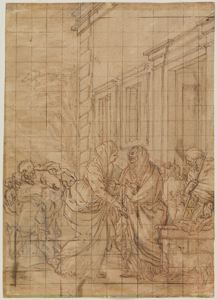Artist: Unknown Artist (Italian, -)
Medium: pen and brown ink, brush and brown wash, red chalk on paper
Dimensions: 15 1/8 in. x 10 13/16 in. (38.4 cm. x 27.5 cm.)
Credit Line: Bequest of the Honorable James Bowdoin III
Accession Number: 1811.127
- six-pointed star over crossed arrows
Type: watermark
Location:
Materials: - "12 Marzo" (with various figures and addition table)
Type: inscription
Location: verso
Materials: pen and brown ink
- James Bowdoin III( Collector, Boston) - 1811.
- Bowdoin College Museum of Art( Museum, Brunswick, Maine) 1811- . Bequest
- Old Master Drawings at Bowdoin College
- Bowdoin College Museum of Art. ( 5/17/1985 - 7/7/1985)
- Clark Art Institute. ( 9/14/1985 - 10/27/1985)
- University of Kansas. ( 1/19/1986 - 3/2/1986)
- Art Gallery of Ontario. ( 5/17/1986 - 6/29/1986)
Type: catalogue Author: Henry Johnson Document Title: Catalogue of the Bowdoin College Art Collections Publ. Place: Brunswick, Maine Reference: no. 139 Remarks: (as Unknown) Section Title: Pt. I, The Bowdoin Drawings Date: 1885 Type: catalogue Author: Bowdoin College Museum of Art Document Title: Bowdoin Museum of Fine Arts, Walker Art Building Edition: 4th Publ. Place: Brunswick, Maine Reference: no. 139 Remarks: (as Unknown) Publisher: Bowdoin College Section Title: Descriptive Catalogue of the . . . Date: 1930 Type: exhibition catalogue Author: David P. Becker Document Title: Old Master Drawings at Bowdoin College Publ. Place: Brunswick, Maine Location: pp. 142-143 Reference: no. 66 Publisher: Bowdoin College Date: 1985
Several suggestions have been made as to the authorship of this drawing, and all have centered in late seventeenth-century Rome. Filippo di Pietro indicated a relationship to Pietro da Cortona, and others have also seen an influence of Carlo Maratti, the other major figure of the period in Rome.1 Among more specific names, Jennifer Montagu suggested Lazzaro Baldi (ca. 1624–1703), and Nicholas Turner, the very plausible idea of Daniel Seiter (1649–1705).
Born in Vienna and principally trained in Venice by Carl Loth, Seiter spent virtually his entire career in Italy, eventually settling after 1688 in Turin. Several stays in Rome during the 1680s and 1690s familiarized him with the Roman school, and drawings of his have been connected with both da Cortona and Maratti.2
The figures behind Mary and Elizabeth are quite Cortonesque, and the overall composition echoes that of the same subject repeated often by Maratti in paintings, drawings, and an etching.3 Comparable drawings in technique and figural style by Seiter are in Windsor Castle and Düsseldorf.4
1. Both Spear and Oberhuber suggested looking in Maratti's circle.
2. See P. Pouncey, "Two Studies by Daniel Seiter for Ceiling Paintings in Turin," Master Drawings, vol. 5, no. 3 (1967), p. 287.
3. See the discussion of Maratti's Visitation grisaille oil sketch at Oxford in Parker 1956, cat. no. 900, and Macandrew 1980, p. 302, no. 900.
4. The Windsor drawings are repr. in Pouncey, op. cit., pls. 28-29; the Düsseldorf sheet is repr. in I. Budde, Beschreibender Katalog der Handzeichnungen in der Staatlichen Kunstakademie Düsseldorf (Düsseldorf, 1930), pl. 234, no. 973.
Commentary credited to David P. Becker (or not otherwise captioned) appeared in his catalogue Old Master Drawings at Bowdoin College (Brunswick: Bowdoin College Museum of Art, 1985).


 Museum of Art
Museum of Art
